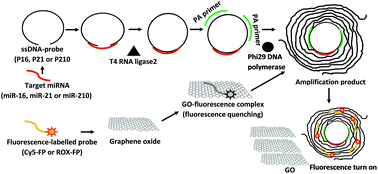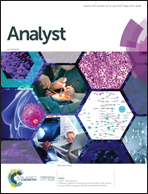Ultrasensitive detection of lung cancer-associated miRNAs by multiple primer-mediated rolling circle amplification coupled with a graphene oxide fluorescence-based (MPRCA-GO) sensor†
Abstract
MicroRNAs (miRNAs) play important roles in gene regulation and have been reported as biomarkers in cancer diagnosis. Herein, we develop an isothermal miRNA detection platform based on the highly efficient, multiple primer-mediated rolling circle amplification method coupled with a graphene oxide-based fluorescence (MPRCA-GO) assay, using lung cancer-associated miRNAs (miR-21 and miR-210) and a reference miRNA (miR-16) as model targets. The combination of the designed ssDNA probe and T4 RNA ligase (T4 Rnl2) used in the MPRCA-GO assay allowed for single-base mismatch discrimination. In addition, the superfluorescence quenching ability of GO allowed for rapid fluorescence detection. The developed platform had a limit of detection as low as 0.87 fM and could detect target miRNAs in cancer cell lines and human serums. Therefore, the MPRCA-GO sensor has the potential for single nucleotide polymorphism (SNP) analysis and applications in clinical diagnostics.

- This article is part of the themed collections: Bioanalytical tools for enabling precision medicine and Analyst Emerging Investigators


 Please wait while we load your content...
Please wait while we load your content...